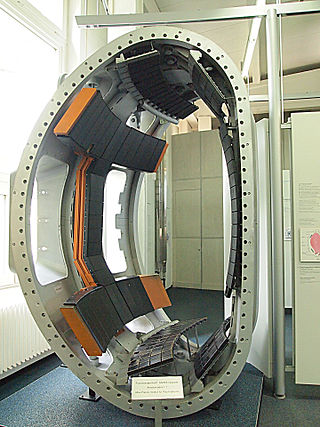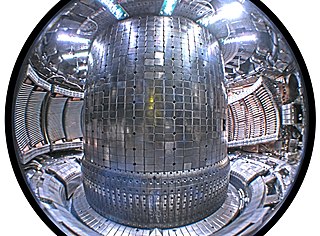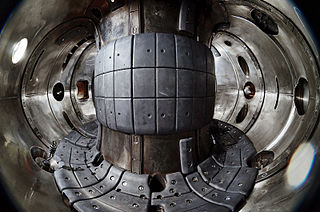Related Research Articles

A tokamak is a device which uses a powerful magnetic field generated by external magnets to confine plasma in the shape of an axially-symmetrical torus. The tokamak is one of several types of magnetic confinement devices being developed to produce controlled thermonuclear fusion power. The tokamak concept is currently one of the leading candidates for a practical fusion reactor.
This timeline of nuclear fusion is an incomplete chronological summary of significant events in the study and use of nuclear fusion.
The Max Planck Institute for Plasma Physics is a physics institute investigating the physical foundations of a fusion power plant. The IPP is an institute of the Max Planck Society, part of the European Atomic Energy Community, and an associated member of the Helmholtz Association.

Magnetic confinement fusion (MCF) is an approach to generate thermonuclear fusion power that uses magnetic fields to confine fusion fuel in the form of a plasma. Magnetic confinement is one of two major branches of controlled fusion research, along with inertial confinement fusion.

The Experimental Advanced Superconducting Tokamak (EAST), internal designation HT-7U, is an experimental superconducting tokamak magnetic fusion energy reactor in Hefei, China. The Hefei Institutes of Physical Science is conducting the experiment for the Chinese Academy of Sciences. It has operated since 2006.

ASDEX Upgrade is a divertor tokamak at the Max-Planck-Institut für Plasmaphysik, Garching that went into operation in 1991. At present, it is Germany's second largest fusion experiment after stellarator Wendelstein 7-X.
ASDEX may refer to:
An edge-localized mode (ELM) is a plasma instability occurring in the edge region of a tokamak plasma due to periodic relaxations of the edge transport barrier in high-confinement mode. Each ELM burst is associated with expulsion of particles and energy from the confined plasma into the scrape-off layer. This phenomenon was first observed in the ASDEX tokamak in 1981. Diamagnetic effects in the model equations expand the size of the parameter space in which solutions of repeated sawteeth can be recovered compared to a resistive MHD model. An ELM can expel up to 20 percent of the reactor's energy.
Ignitor is the Italian name for a planned tokamak device, developed by ENEA. As of 2022, the device has not been constructed.
Plasma–Surface Interaction (PSI) studies study the interaction at the interface between plasma and materials. Focus of the research lies on providing both theoretical and experimental support to the design and validation of plasma facing materials for the fusion experiment ITER and future devices.

In nuclear fusion power research, the plasma-facing material (PFM) is any material used to construct the plasma-facing components (PFC), those components exposed to the plasma within which nuclear fusion occurs, and particularly the material used for the lining the first wall or divertor region of the reactor vessel.

A ball-pen probe is a modified Langmuir probe used to measure the plasma potential in magnetized plasmas. The ball-pen probe balances the electron and ion saturation currents, so that its floating potential is equal to the plasma potential. Because electrons have a much smaller gyroradius than ions, a moving ceramic shield can be used to screen off an adjustable part of the electron current from the probe collector.

COMPASS, short for Compact Assembly, is a compact tokamak fusion energy device originally completed at the Culham Science Centre in 1989, upgraded in 1992, and operated until 2002. It was designed as a flexible research facility dedicated mostly to plasma physics studies in circular and D-shaped plasmas.
Hartmut Zohm is a German plasma physicist who is known for his work on the ASDEX Upgrade machine. He received the 2014 John Dawson Award and the 2016 Hannes Alfvén Prize for successfully demonstrating that neoclassical tearing modes in tokamaks can be stabilized by electron cyclotron resonance heating, which is an important design consideration for pushing the performance limit of the ITER.
The China Fusion Engineering Test Reactor, or CFETR, is a proposed tokamak fusion reactor, which uses a magnetic field in order to confine plasma and generate energy. As of 2015, tokamak devices are leading candidates for the construction of a viable and practical thermonuclear fusion reactor. These reactors may be used to generate sustainable energy whilst ensuring a low environmental impact and a smaller carbon footprint than fossil fuel-based power plants.
Friedrich E. Wagner is a German physicist and emeritus professor who specializes in plasma physics. He was known to have discovered the high-confinement mode of magnetic confinement in fusion plasmas while working at the ASDEX tokamak in 1982. For this discovery and his subsequent contributions to fusion research, was awarded the John Dawson Award in 1987, the Hannes Alfvén Prize in 2007 and the Stern–Gerlach Medal in 2009.

HL-2M is a research tokamak at the Southwestern Institute of Physics in Chengdu, China. It was completed on November 26, 2019 and commissioned on December 4, 2020. HL-2M is now used for nuclear fusion research, in particular to study heat extraction from the plasma. With a major radius of 1.78 m, the tokamak is a medium-scale device. The magnetic field of up to 2.2 T is created by non-superconducting copper coils.
Donato Palumbo was an Italian physicist best known as the leader of the European Atomic Energy Community (Euratom) fusion research program from its formation in 1958 to his retirement in 1986. He was a key force in the development of the tokamak during the 1970s and 80s, contributing several papers on plasma confinement in these devices and leading the JET fusion reactor program, which as of 2021, retains the record for the closest approach to breakeven, the ratio between the produced fusion power and the power used to heat it. He is referred to as the founding father of the European fusion program.
Thailand Tokamak-1 is a small research tokamak operated by the Thailand Institute of Nuclear Technology in Nakhon Nayok province, Thailand. The tokamak was built in collaboration with the Institute of Plasma Physics of the Chinese Academy of Sciences and features an upgraded design based on the HT-6M tokamak developed in 1984. The first successful test of the device occurred on 21 April 2023. TT-1 officially began operations on 25 July 2023 and became the first tokamak to operate in Southeast Asia.
References
- ↑ Liu, Dequan; Zhou, Caipin; Cao, Zeng; Yan, Jiancheng; Liu, Yong (2003). "Construction of the HL-2A tokamak". Fusion Engineering and Design. 66–68: 147–151. Bibcode:2003FusED..66..147L. doi:10.1016/S0920-3796(03)00165-0. ISSN 0920-3796.
- ↑ Isabella Milch (2002-12-02). "ASDEX – German fusion device now re-operating in China".
- ↑ "HL-2A". SIno-French Fusion Energy centeR. 2017-11-17.